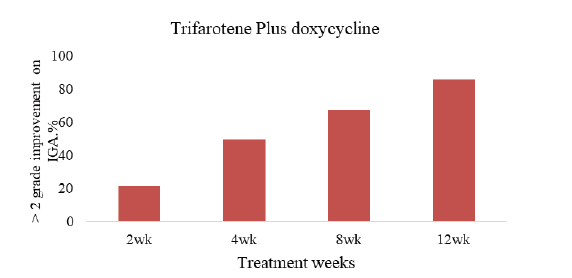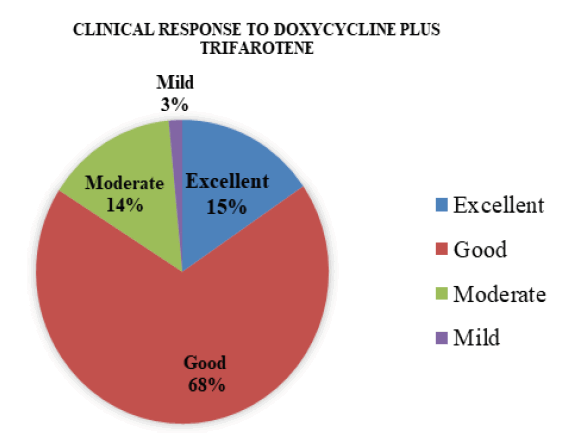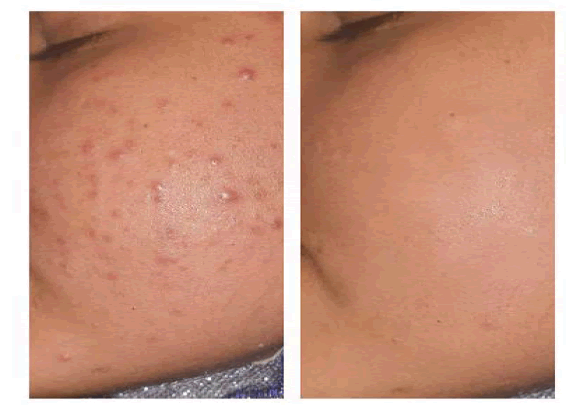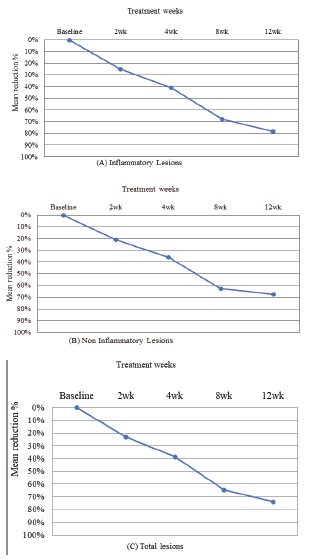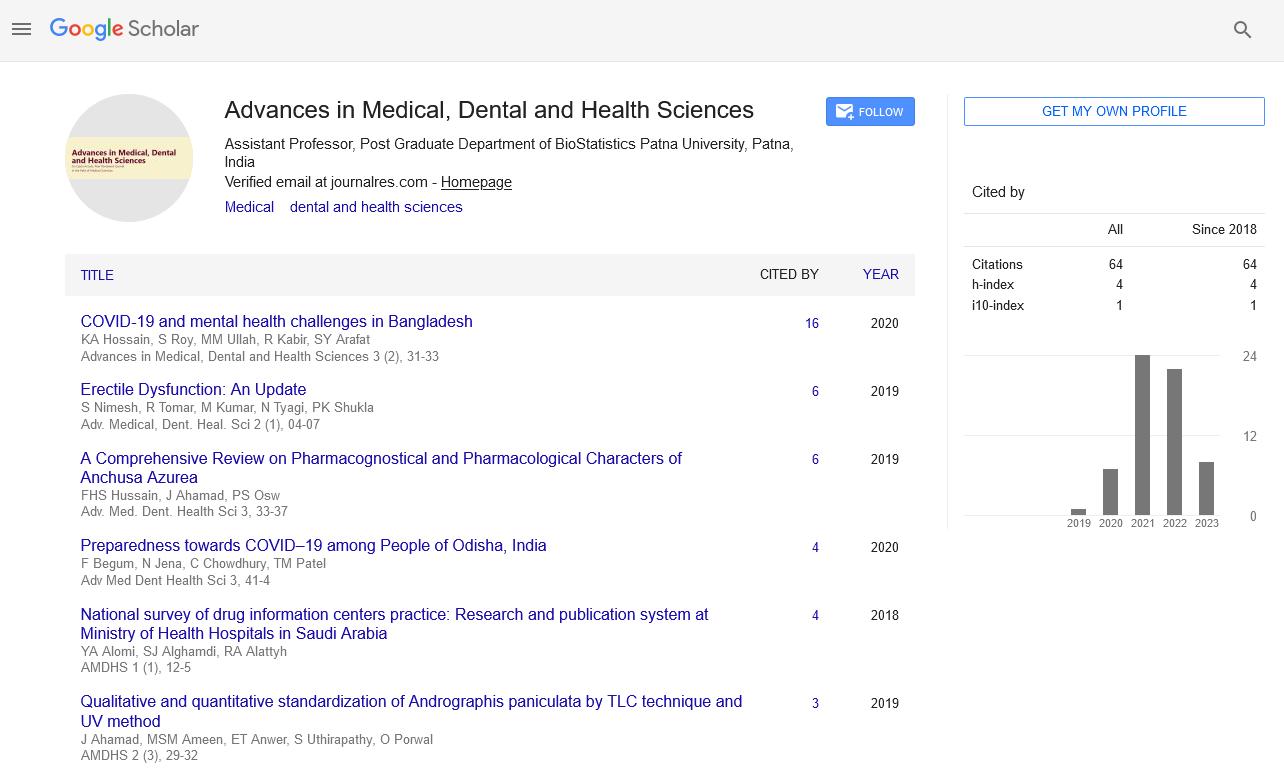Case Report - (2023) Volume 6, Issue 1
A Study of the Efficacy of Doxycycline plus Trifarotene in the Treatment of Moderate to Severe Acne Vulgaris
Md. Rezaul Islam1*, Md. Abu Baker2, Nelson Taposh Mondal3, Md. Momenuzzaman Khan4 and Md. Mahbub Hossain52Department of Dermatology and Venereology, Enam Medical College and Hospital, Savar, Dhaka, Bangladesh
3Medicine, Enam Medical College & Hospital, Saver, Dhaka, Bangladesh
4Department of Neurology, Enam Medical College & Hospital, Savar, Dhaka, Bangladesh
5Medicine, Enam Medical College, Savar, Dhaka, Bangladesh
Received: Mar 01, 2023, Manuscript No. amdhs-23-90482; Editor assigned: Mar 03, 2023, Pre QC No. amdhs-23-90482 (PQ); Reviewed: Mar 06, 2023, QC No. amdhs-23-90482 (Q); Revised: Mar 12, 2023, Manuscript No. amdhs-23-90482 (R); Published: Mar 28, 2023, DOI: 10.5530/ amdhs.2023.1.5
Abstract
Introduction: Acne is a common cutaneous disease affecting the pilosebaceous apparatus, in which there is hyperkeratinization, excessive sebum production, follicular colonization with Propionibacteriun acnes & inflammation. It manifests as comedones, papules, pustules, nodules & cysts on the face, neck, and trunk.
Epidemiologic studies indicate acne affects approximately 9.4% of the global population, ranking it as the eighth most prevalent disease worldwide. It is a common skin condition of the face and trunk that negatively impacts the quality of life.
Objectives: We evaluated the efficacy of oral doxycycline in combination with topical trifarotene in the treatment of moderate to severe acne vulgaris.
Methods: This was an interventional study for 12-week duration to see the treatment outcome in moderate & severe acne patients. This study was carried out at the Dept. of Dermatology & Venereology, Enam medical college Hospital, Savar, Dhaka, Bangladesh from January 2022 to September 2022. We evaluated a new therapeutic regimen: Doxycycline 100 mg (Oral) once daily during dinner with food and enough water, 21 days/month, for three consecutive months along with topical Trifarotene 0.005%w/w once daily at night after proper cleansing for the same duration. Acne severity was graded using Investigator Global Acne Assessment Scale (IGAS).
Results: A total of 96 patients with moderate to severe acne were treated & among them 85 completed this study. Out of these 85, 15 are males & 70 are females. There was a marked improvement in IGAS with marked reduction in the number of inflammatory and non-inflammatory lesions between the beginning of the study and through follow up visits. Clinical response to Doxycycline Plus Trifarotene was excellent in 15%, good in 68%, moderate in 14% and mild in 3% and satisfaction to treatment was 22% very satisfied, 60% satisfied and 17% somewhat satisfied. Side effects were low and only 2.1% of cases had mild irritation.
Conclusion: Doxycycline plus Trifarotene is effective and safe in the treatment of AV with minimal side effects.
Keywords
Doxycycline, Trifarotene, Acne, Vulgaris
Introduction
Acne vulgaris is a common skin disease that manifests as comedones, papules, pustules, nodules and cysts on the face, neck, and trunk. Epidemiologic studies indicate acne affects approximately 9.4% of the global population, ranking it as the eighth most prevalent disease worldwide [1]. Up to 85% of adolescents experience acne and while often mistakenly perceived as a disease limited to teenagers, many adults are affected as well [2]. The psychosocial effects of acne are well documented and include negative impacts on self-perception, social functioning, and mental health [2,3]. Furthermore, any severity of acne can result in long lasting scarring, a risk that tends to increase as disease severity worsens [4,5]. Current treatment options for acne includes interventions with topical medications in mild-to moderate disease with the addition of systemic medications as severity increases [6]. Some options include tretinoin, azelaic acid, benzoyl peroxide, sulfer, salicyclic acid, resorcinol, or routine face washing with mild soap [7]. Antibiotics that can be used for acne include tetracycline, doxycycline, erythromycin, minocycline, azithromycin and clindamycin [8-13]. Oral antibiotics are frequently prescribed to treat severe acne and are recommended by acne treatment guidelines, with the precaution to limit the period of treatment to the minimum necessary to reduce the risk of antibiotic resistance. [14,15]. Doxycycline is a useful antibiotic in acne due to its antibacterial and anti-inflammatory effects. The recommended treatment consists of 1 capsule per day (100 mg Doxycycline) for 3 months. Long antibiotic treatments in acne patients produce unwanted side effects [16, 17]. Doxycycline has an overall favourable efficacy and safety profile; however, current acne recommendations suggest limiting duration of use to minimize risks for antimicrobial resistance [18, 19]. Trifarotene is a new first-in-class fourth-generation topical retinoid that has been uniquely studied in the treatment of both facial and truncal acne. Through selective agonism of Retinoic Acid Receptor (RAR)-gamma, the most predominant RAR isotype in the epidermis, trifarotene exerts more targeted, skin-specific effects than earlier generation retinoids [20,21]. The current interventional study was designed to provide information about the efficacy and safety of doxycycline plus trifarotene in patients with moderate to severe facial acne.
Materials and Methods
This was a prospective open labelled interventional study carried out at the Dept. of Dermatology & Venereology, Enam Medical College Hospital, Savar, Dhaka, Bangladesh from January 2022 to September 2022. We`evaluated a new therapeutic regimen: Doxycycline 100 mg (Oral) once daily during dinner with food and enough water, 21 days/month, for three consecutive months along with topical Trifarotene 0.005%w/w once daily at night after proper cleansing for the same duration.
The patients were selected from the OPD of dermatology and venereology department provided that the patients have not received any medication, either topical or systemic treatment for AV during the previous 2 weeks. Patients were evaluated by careful history taking, general examination, complete dermatological examination including type of acne and counting of inflammatory and non-inflammatory acne lesions, after taking informed written consents. Patients, allergic to doxycycline, pregnant and lactating women or women who are planning for pregnancy and patients on isotretinoin treatment within 3 months before the beginning of the study were excluded from this study. Although the importance of completing the entire clinical study was explained to the subjects, any subject was free to discontinue his or her participation in the study at any time and for whatever reason, specified or unspecified and without prejudice. No constraints were imposed on the subject and when appropriate, a subject would have been treated with other conventional therapy when clinically indicated.
Acne severity was graded using Investigator Global Acne Assessment Scale (IGAS), along with lesional photography for each patient before the start of treatment with Doxycycline plus Trifarotene. The severity of acne was determined as 5 grades (clear, almost clear, mild, moderate and severe), depending upon the number of inflammatory and non-inflammatory lesions.
The treatment regimen consisted of Doxycycline 100 mg (oral) once daily during dinner with food and enough water, 21 days/month, for three consecutive months along with topical Trifarotene 0.005%w/w once daily at night after proper cleansing for the same duration.
The patients were re-evaluated at 2, 4, 8 and 12 weeks of treatment (the end of therapy), using IGAS, lesional photography together with recording satisfaction of the patient by 4 points scale (as 1= not satisfied, 2= somewhat satisfied, 3= satisfied and 4= very satisfied) Patient’s response to treatment was recorded and classified using 6 points scale into excellent, good, moderate, mild, unchanged and worse [14]. Safety and patient’s compliance were recorded at each follow up visits.
Statistical Analysis
All data were collected by a structured questionnaire containing all the variables. Efficacy, safety and vital signs were summarized by analysis visit. Data were checked, entered and analysed by using (SPSS version 20) software computer package. Data were expressed as mean ± Standard Deviation (SD) for quantitative variables, number and percentage for categorical variables. P value <0.05 indicated significant results.
Results
A total of 96 patients with moderate to severe acne were treated & among them 85 completed this study. Out of these 85, 15 (17.7%) are males and 70 (82.3%) are females. Their ages ranged between 14 years to 29 years (mean=19.45 ± 2.55). The duration of acne ranged from 1 month to 3 years with a mean ± SD (1.85 ± 0.7) (FIGURE 1).
The Demographic data and duration of disease of the studied are presented in (TABLE 1 and TABLE 2).
| Variable | (N=85) |
|---|---|
| Age (years): | 14-29 |
| Mean ± SD | 19.45 ± 2.55 |
| Duration (years): | 1 month – 3 years |
| Mean ± SD | 1.85 ± 0.7 |
| Variable | No | Percentage |
|---|---|---|
| Male | 15 | 17.7 |
| Female | 70 | 18.3 |
As regards IGAS at different follow up times in studied patients, at the beginning of treatment 33% of the cases were suffering from severe degree, 67% have moderate acne. After 12 week no severe cases were found and only 5% were moderate, 61% were mild and 34% of the cases became almost clear. There were statistically significant differences in IGAS between base line and all other follow up weeks in severity of disease among the studied patients (TABLES 3 to TABLE 5).
| Variable | (N=85) | % | P value |
|---|---|---|---|
| IGAS: Base line | |||
| Moderate | 57 | 67 | 0.02 |
| Severe | 28 | 33 | |
| IGAS: 2nd week | |||
| Mild | 18 | 21.2 | <0.001 |
| Moderate | 45 | 52.9 | |
| Severe | 22 | 25.8 | |
| IGAS: 4th week | <0.001 | ||
| Mild | 42 | 49.5 | |
| Moderate | 31 | 36.5 | |
| Severe | 12 | 14 | |
| IGAS: 8th week | <0.001 | ||
| Almost clear | 20 | 23.5 | |
| Mild | 57 | 67 | |
| Moderate | 8 | 9.5 | |
| IGAS: 12th week | <0.001 | ||
| Almost clear | 29 | 34 | |
| Mild | 52 | 61 | |
| Moderate | 4 | 5 |
| Variables | (N=96) |
|---|---|
| Subjects randomized and treated who completed this study | 85 (88.5) |
| Subjects randomized and treated who discontinued this study | 11 (11.5) |
| Adverse event | 2 (2.1) |
| Lost to follow-up | 4 (4.2) |
| Withdrawal by parent/guardian | 1 (1.04) |
| Withdrawal by subject | 4 (4.2) |
| Other | 0 (0.0) |
| Variables | Cases (N=85) | |
|---|---|---|
| N | % | |
| Satisfaction | ||
| Not satisfied | 0 | 0 |
| Somewhat satisfied | 15 | 17 |
| Satisfied | 51 | 60 |
| Very satisfied | 19 | 22 |
There was no statistically significant re la tion between duration of acne and IGAS, response to treatment or satisfaction. No statistically significant d i fference be tw een ma le s an d fe ma les as regard response to treatment (P>0.05). The photo documentations of clinical improvement from baseline to Week 12 in subjects treated with once-daily doxycycline plus trifarotene are presented in FIGURE 2 - FIGURE 4.
From baseline to week 12, patients treated with Doxycycline plus trifarotene showed mean percent reduction of total lesions by 73.8%. There was mean reduction of 78.1% in inflammatory lesions and 69.5% in non-inflammatory lesions after 12 week of treatment with Doxycycline plus trifarotene. Mean percent reduction of inflammatory lesions were more as compared to noninflammatory lesions as seen in FIGURE 5 A-C.
Discussion
Acne vulgaris is an inflammatory disease of pilosebaceous apparatus. It is clinically characterized by comedones, papules, pustule, nodule, cyst and occasional scarring. Hyperkeratinization, excessive sebum & inflammatory mediators production, follicular colonization with Propionibacteriun acnes are the factors for pathogenesis of acne [22]. Acne has a wellestablished link to depression, anxiety, and a diminished quality of life [23]. According to the Global Burden of Disease Study 2010, acne vulgaris is the eighth most common cutaneous ailment, with a global prevalence of 9.38% [24]. Retinoids are the core of topical therapy for acne because they are comedolytic, cure the antecedent microcomedone lesion and are anti-inflammatory. According to the AAD recommendations, they also allow for the maintenance of clearance [25,26]. There are relatively few published studies reporting the efficacy of combining oral doxycycline & topical trifarotene treatment regimens in moderate to severe acne; thus, there is a need for evidence-based information concerning treatment options in this patient population [27]. As research is still evolving in the case of trifarotene, data continue to pour from all over the world. However, trifarotene has been accepted well by patient groups and dermatologists globally. The combination of trifarotene plus oral doxycycline was a safe and effective treatment regimen in subjects with severe acne. There were highly significant and clinically relevant improvements in both IGA and lesion counts after 12 weeks of active treatment [28]. Stein-Gold et al. have reported that both acne lesion types and lesion quantities should be considered in an overall assessment of acne severity [29]. Oral Isotretinoin is an effective treatment for severe acne, but it has side effects that some patients consider intolerable and that can sometimes persist after treatment cessation [30]. A 52-week study (n=453) showed trifarotene has good safety and tolerability, with adverse effects that occurred in approximately 10% of subjects, usually in the first three months of therapy, were mostly cutaneous, and were non-serious [31]. Oral antibiotics are frequently prescribed in a survey of general practitioners in Ireland (n=298), 17% indicated that they would prescribe isotretinoin therapy, citing long wait times for dermatology consultation. The remaining 83% of respondents who did not prescribe isotretinoin gave the following as barriers to use: medical-legal concerns (61%), lack of awareness that they could prescribe isotretinoin (55%) and lack of familiarity in managing patients on isotretinoin (41%) [32]. The other study by Landis reported that prescribing and monitoring protocols have wide variations among clinicians, suggesting that much could be done to optimize use of isotretinoin. However, until change occurs, it is vital for clinicians to have alternatives to isotretinoin therapy for patients with severe acne. An acne flare may occur at the beginning of oral retinoid treatment, providing a rationale for using a topical retinoid before initiating therapy. In addition, isotretinoin monitoring can be troublesome for both clinicians and patients [33]. The potential for teratogenicity has led to creation of stringent pregnancy prevention programs in many countries, such as the somewhat controversial risk evaluation and mitigation program named iPLEDGE in the United States. [34]. Two large-scale Phase III trials involving a total of 2,420 patients with moderate acne showed trifarotene monotherapy achieved Investigator Global Assessment (IGA) success (clear/almost clear plus at least 2-grade improvement) rates of 42.3% and 29.4% by study endpoint at Week 12 (P<0.001 vs. vehicle). Despite the limited comparability of existing studies in severe acne, published data support the conclusions of this study that the combination of a retinoid with oral doxycycline is an appropriate regimen for moderate & severe acne [23,35,36]. In our study, the combination of trifarotene plus oral doxycycline was a safe and effective treatment regimen in subjects with moderate to severe acne. There were highly significant and clinically relevant improvements in both IGA and lesion counts after 12 weeks of active treatment. Patients were instructed properly about applying medication and the use of cleanser and moisturizer also may have contributed in clinical response.
Conclusion
Oral antibiotic combined with topical retinoid are an efficacious therapy for moderate to severe acne, such as Doxycycline plus Trifarotene are effective and safe in the treatment of AV with minimal side effects. This evaluation will encourage us to apply the treatment regimen in a larger scale.
Conflict of Interest
None.
Source of Funding
Nil.
References
- Djalalinia S, Saeedi Moghaddam S, Moradi-Lakeh M, et al. Prevalence and years lived with disability of 310 diseases and injuries in Iran and its neighboring countries, 1990-2015: findings from global burden of disease study 2015. Arch Iran Med. 20(7), 392-402 (2017).
- Collier CN, Harper JC, Cantrell WC, et al. The prevalence of acne in adults 20 years and older. J Am Acad Dermatol. 58(1), 56-59 (2008).
- Tan JK and Bhate K. A global perspective on the epidemiology of acne.Br J Dermatol. 172(S1), 3-12 (2015).
- Misery L, Wolkenstein P, Amici JM, et al. Consequences of acne on stress, fatigue, sleeps disorders and sexual activity: a population-based study. Acta derm venereol. 95(4), 485-488 (2015).
- Basak SA and Zaenglein AL. Acne and its management. Pediatr rev. 34(11), 479-497 (2013).
- Zaenglein AL, Pathy AL, Schlosser BJ, et al. Guidelines of care for the management of acne vulgaris.J Am acad Dermatol. 74(5), 945-973 (2016).
- Lasek RJ and Chren MM. Acne vulgaris and the quality of life of adult dermatology patients. Arch Dermatol. 134(4), 454-458 (1998).
- Heng AH and Chew FT. Systematic review of the epidemiology of acne vulgaris. Sci rep.10(1), 5754 (2020).
- Dréno B, Layton A, Zouboulis CC, et al. Adult female acne: a new paradigm. J Eur Acad Dermatol Venereol. 27(9), 1063-1070 (2013).
- George R, Clarke S and Thiboutot D. Hormonal therapy for acne. InSeminars cuta. med surg. 27(3),188-196 (2008).
- Dreno B, Thiboutot D, Gollnick H et al. Antibiotic stewardship in dermatology: limiting antibiotic use in acne. Eur J Dermatol. 24, 330-334 (2014).
- Leyden JJ, Shalita A, Thiboutot D et al. Topical retinoids in inflammatory acne: a retrospective, investigator-blinded, vehicle-controlled, photographic assessment. Clin Ther. 27(2), 216-224 (2005).
- Thielitz A and Gollnick H. Topical retinoids in acne vulgaris: update on efficacy and safety. Am j clin dermatol. 9, 369-381 (2008).
- Czernielewski J, Michel S, Bouclier M et al. Adapalene biochemistry and the evolution of a new topical retinoid for treatment of acne. J Euz Acad Dermatol Venereol. 15, 5-12 (2001).
- Thiboutot DM, Dréno B, Abanmi A et al. Practical management of acne for clinicians: An international consensus from the Global Alliance to Improve Outcomes in Acne. J Am Acad Dermatol. 78(2), S1-23 (2018).
- Gollnick H, Cunliffe W, Berson D et al. Management of acne: a report from a Global Alliance to Improve Outcomes in Acne. J Am acad dermatol. 49(1), S1-37 (2003).
- Khorvash F, Abdi F, Kashani HH et al. Staphylococcus aureus in acne pathogenesis: a case-control study. N Am j med Sci. 4(11), 573 (2012).
- Tan AU, Schlosser BJ and Paller AS. A review of diagnosis and treatment of acne in adult female patients. Int j women's dermatol. 4(2), 56-71 (2018).
- Tan J, Beissert S, Cook-Bolden F et al. Impact of facial and truncal acne on quality of life: A multi-country population-based survey.JAAD int. 3, 102-110 (2021).
- Kolli SS, Pecone D, Pona A et al. Topical retinoids in acne vulgaris: a systematic review. Am j clin dermatol. 20, 345-365 (2019).
- Thoreau E, Arlabosse JM, Bouix-Peter C, et al. Structure-based design of Trifarotene (CD5789), a potent and selective RARγ agonist for the treatment of acne. Bioorg med chem Let. 28(10), 1736-1741(2018).
- Tan J, Schlessinger J, Brodell R, et al. Short-term combination therapy and long-term relapse prevention in the treatment of severe acne vulgaris. J drugs dermatol. JDD. 11(2), 174-180 (2012).
[Googlescholar] [Crossref]
- Tan J, Thiboutot D, Popp G, et al. Randomized phase 3 evaluation of trifarotene 50 μg/g cream treatment of moderate facial and truncal acne. J Am Acad Dermatol. 80(6), 1691-1699 (2019).
- Blumeâ?Peytavi U, Fowler J, Kemény L, et al. Longâ?term safety and efficacy of trifarotene 50 μg/g cream, a firstâ?inâ?class RARâ?γ selective topical retinoid, in patients with moderate facial and truncal acne. J Eur Acad Dermatol Venereol. 34(1), 166-173 (2020).
- Brumfiel CM, Patel MH, Bell KA, et al. Assessing the safety and efficacy of trifarotene in the treatment of acne vulgaris. Ther Clin Risk Manag. 755-763 (2021).
- Thiboutot D, Gollnick H, Bettoli V, et al. New insights into the management of acne: an update from the Global Alliance to Improve Outcomes in Acne group. 60(5), S1-50 (2009).
- Del Rosso JQ, Johnson SM, Schlesinger T, et al. A Randomized, Controlled Trial of Trifarotene Plus Doxycycline for Severe Acne Vulgaris. J Clin Aesthet Dermatol. 15(7), E53 (2022).
[Googlescholar] [Crossref]
- Miller JJ and Clarke JT. Individualizing patient education for greater patient satisfaction. Cutis. 95(5), 291-292 (2015).
[Googlescholar] [Crossref]
- Tan J, Kircik L. Evolution of acne assessments and impact on acne medications: an evolving, imperfect paradigm. J drugs dermatol. JDD. 15(1), 79-86 (2016).
- Hull PR and Demkiw-Bartel C. Isotretinoin use in acne: prospective evaluation of adverse events. J cutan med surg. 4(2), 66-70 (2000).
- Blumeâ?Peytavi U, Fowler J, Kemény L, et al. Longâ?term safety and efficacy of trifarotene 50 μg/g cream, a firstâ?inâ?class RARâ?γ selective topical retinoid, in patients with moderate facial and truncal acne. J Eur Acad. Dermatol Venereol. 34(1), 166-173 (2020).
- Carmody K, Rouse M, Nolan D, et al. GPs’ practice and attitudes to initiating isotretinoin for acne vulgaris in Ireland: a cross-sectional questionnaire survey in primary care. Br J Gen Pract. 70(698), e651-656 (2020).
- Landis MN. Optimizing isotretinoin treatment of acne: update on current recommendations for monitoring, dosing, safety, adverse effects, compliance, and outcomes. Am j clin dermatol. 21(3), 411-419 (2020).
- Barbieri JS, Frieden IJ and Nagler AR. Isotretinoin, patient safety, and patient-centered care—time to reform iPLEDGE. JAMA dermatol. 156(1), 21-22 (2020).
- Dréno B, Kaufmann R, Talarico S, et al. Combination therapy with adapalene–benzoyl peroxide and oral lymecycline in the treatment of moderate to severe acne vulgaris: a multicentre, randomized, doubleâ?blind controlled study. Br. J. Dermatol. 165(2), 383-390 (2011).
- Gold LS, Cruz A, Eichenfield L, et al. Therapeutics for the Clinician-Effective and Safe Combination Therapy for Severe Acne Vulgaris: A Randomized, Vehicle-Controlled, Double-blind Study of Adapalene 0.1%-Benzoyl Peroxide 2.5% Fixed-Dose Combination Gel With Doxycycline Hyclate 100 mg. Cutis. 85(2), 94 (2010).
[Googlescholar] [Crossref]
